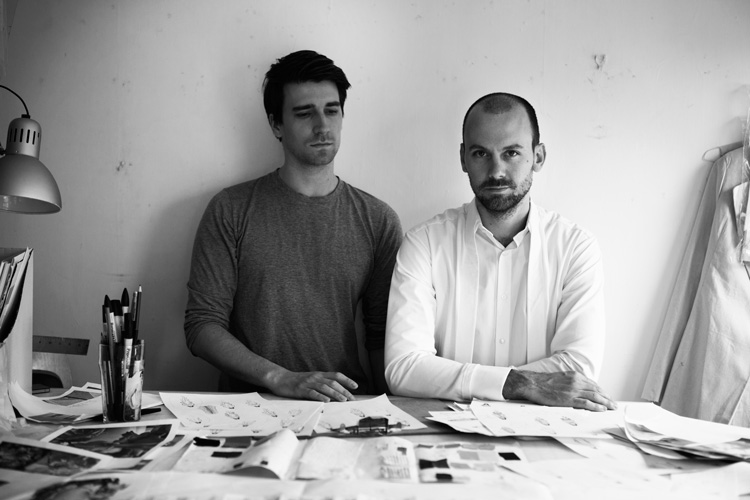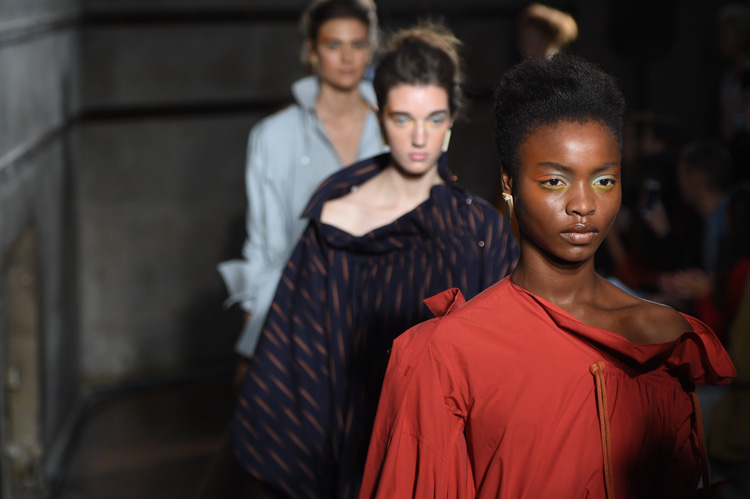PALMER//HARDING KNOW HOW TO WORK THE SHIRT, AND OFFER UP PROGRESSIVE REIMAGINING’S OF THE WARDROBE STAPLE.

Launched in 2012 by Levi Palmer and Matthew Harding, palmer//harding is a designer brand specialising in the shirt. Through innovative pattern cutting and draping techniques, the duo create modern, exquisitely crafted shirts that bridge the line between wardrobe essential and modern statement.
Texas born Palmer and British born Harding met while studying at London’s Central St Martins. After dabbling in both men’s and women’s lines at the start of the brand’s launch, the pair decided to streamline their focus to womenswear only, and voilà, palmer//harding as we know it today was born. In honing their focus on perfecting one simple garment, a wardrobe staple, the dynamic duo has earned a legion of loyal fans for their signature shirting, with waterfall back hems and based on the idea of movement and fluidity, but with a sense of control. Their contemporary take on tailoring is keenly cut to flatter, not swamp.
Here we take the opportunity to talk to the London-based pair who have become synonymous with the shirt, about bridging the line between wardrobe essential and modern statement.

Can you tell us about how you conceived the idea for palmer//harding?
We launched in Spring Summer 2012 with the intention of becoming known as leaders in directional shirting.
Why shirting?
Our focus for shirting began at Central St Martins, when we had to do a shirt project in our first year. After we graduated we felt that this was an area which we wanted to continue exploring, and so we started the label.
What is your design aesthetic?
Directional shirting with a feminine edge, together with clever pattern cutting and volume.
Who is the palmer//harding woman?
We aim to keep the palmer//harding woman as ambiguous as possible, she’s everyone from a CEO to an art student, she’s 18 to 80. In this way we keep our brand attainable to a wide range of consumers, within price point and the wearability of the garments.
When you first met, did you imagine that you would end up creating a successful brand together?
Neither of us wanted to start a label, but after graduating and becoming disillusioned with the jobs that we had found in the industry we felt that starting our own label would provide us with more creative freedom.
How do you balance the duties of design when working as a duo? Do you ever disagree on design matters?
LEVI: We both manage design elements of the brand. I wouldn’t say we disagree, but we challenge each other with different creative views and this propels us to progress our design ideas further.
MATTHEW: I manage production and finance, and Levi looks after marketing and sales.

How do your styles differ, and how do you combine them?
LEVI: I tend to be more fluid and drape, while Matthew tends to add in a bit more of the structure. What usually happens is I will drape a shape or silhouette and Matthew will take that and add in additional detailing or play with the proportions to create something that feels completely both of ours.
What part of the creative process do you enjoy the most?
MATTHEW: I think we both really enjoy the early research and development, where it’s all a puzzle which slowly comes together. After the excitement of that early design process it’s always a bit of a challenge to fine tune and refine the ideas to make them meet the vision, but when it comes together at the end its always really exciting.
What is your favourite thing about each other? What do you respect most about each other?
LEVI: Matthew is incredibly detail oriented, which can be frustrating at times, but more often than not it is his attention to detail that helps us avoid mistakes.
MATTHEW: Levi is a people pleaser which of course has its pit falls, but equally this has allowed him to develop some incredibly strong relationships with mentors and friends in the industry who have supported us along the way.

Do each of you tend to concentrate on different aspects of both business and design, or balance the responsibilities?
We both share the design responsibilities, it’s what we’ve studied and what we enjoy doing. We have to be strict with ourselves when splitting our time between design and the day to day running of the company. Recently we’ve moved our desks into a private office, which has allowed us to make business decisions much quicker now that we have privacy. Even though we both have different parts of the business we focus on there is not one aspect that we don’t discuss with each other before taking action.
Is working as a pair a good motivation for each of you? Do you think working as a team helps you create a stronger brand as you have more idea input, and your focus can be spread?
We first started the label in Matthew’s parents’ home, interns had to travel out to Rickmansworth, just outside London, to work for us, and as we were in Matthew’s home his mother would make lunch and we would always break at 1pm to eat together and ensure everyone left at 6pm. Once we were able to move into London we carried this trait with us and even though we have gone from being 4 employees to 12 over the past year, each hire we’ve made we have ensured that they will fit in with our office atmosphere. We still break for lunch at 1pm each day, but now eat around a much bigger table. We consider all our staff to be extended family and try to keep this environment as much as possible as we grow. It’s this attitude that I think makes our brand different, and we hope that the caring nurturing environment here at palmer//harding HQ can be felt by our customers when they wear our clothes.

Tell us about your recent Spring Summer 2018 collection?
We have continued to play with our signature asymmetry, movement and volume through ruffles, folds and rope detailing, whilst adding in off-centre ruched necklines, cascading hems, balloon sleeves, deep pleating, drawstring waists and exaggerated cuffs. Overall, there’s a nonchalance to the collection that’s not casual but more assertive and expressive. It’s power dressing for women but without the overtly masculine signifiers.
What was the inspiration behind it?
We explored the idea of memory, from how something in the past shapes who you are today, to how in remembering you focus on certain details while others remain hazy in the background, and even the imperfection of memory itself. Through it all, we found a melancholic optimism that bestows a relaxed sense of empowerment and expressionistic movement in the collection.
Do you have a favourite piece from the collection?
The super shirt, our long asymmetric white poplin shirt that flows in the wind like a cape is always a great go to piece!
Do you have a muse? Or someone in mind who embodies palmer//harding?
Jan Strimple. Levi interned for her back in Texas and she has shown unwavering support and a consistent flow of advice. She is a former model and now runway producer, formidable both in her presence, kindness, and her knowledge.
Who have you been most excited to see wearing your clothes? And why?
Michelle Obama wearing our Super Shirt was hugely exciting. It was her first public appearance since leaving office and she was speaking at the Healthier America Summit which is a cause we feel passionately about.
Now that you don’t just design shirts, do you still think of yourselves as a shirting brand?
Even though we’ve expanded our collection to include dresses, skirts, trousers, and coats, our USP is a focus on shirting. We sell other pieces with great success but at the end of the day it’s the white and blue pinstripes shirts with clever pattern cutting and volume that we have become synonymous with. Additionally, as we have grown we have always maintained that the shirts come first, so if we design a voluminous shirt we then have to design a jacket that would be worn over it or think what sort of trouser would our woman wear with this piece. If we have a great detail on a shirt we then ask how that can be transferred to a dress so that the reference is always the shirt. So, no matter what addition we add to the range we still keep the shirt as the centre of our design ethos.

Shirting has been a huge runway trend of late, what do you think it is that has elevated shirting over the past few seasons particularly?
There are so many elements within shirting which we continue to explore and enjoy doing so. I think what has made this such a trend is that the shirt is one of the most classic and versatile garments to wear.
Fit, cut and construction all seem to be parts of the perfect shirt, what defines shirting to you?
We play with the idea of draping and volume within shirting, but fit, cut and construction is always key, and we go through numerous fitting sessions and sampling ahead of creating the final piece. Because we use a lot of volume in our designs, we test how our pieces look whilst walking to see if there needs to be more or less material added to create the desired effect. We will also make slight adjustments to key pieces season on season, and this could include looking at how the seams are finished or how the collar sits, so there are always slight updates and improvements to be made even to our bestselling styles.
Do you design shirts with the idea of empowering women?
We design shirts with the idea of creating wearable yet directional pieces for working women in mind. We feel that shirting signifies the idea of power, sexuality, and romance within the confines of a versatile garment.
In your opinion, what is the most flattering silhouette on a woman?
We love a loose silhouette, something that caresses the body and emphasises the grace a woman carries in her natural movement.
What made you decide to focus solely on womenswear, and stop producing menswear?
Womenswear provided a lot more creative freedom, and as our team is still small we wanted to be able to do one category the best we could, rather than split our focus.
Where do you now buy your own shirts from?
We will either custom make our own or wear the womenswear styles. The Poet shirt is quite unisex as it’s like a painter’s smock.

How would you say your brand has grown and matured since you launched in 2012?
We understand our woman a lot more and also understand our own strengths as designers.
What do you feel is key to the growth of the brand, and has been key so far in the journey of the brand?
Refocussing our collection to focus on cotton shirting and reducing our price point for Resort 2016 was a big turning point in our brand, this allowed us to become a more commercially viable brand which was taken on by stockists such as MatchesFashion.com. Since then we have stayed true to ourselves, not rushed our success, ensuring that each decision is thought through, whilst remaining organised.
What’s the secret to a successful label?
Persistence. You can’t give up no matter what obstacles you face.
READ MORE















